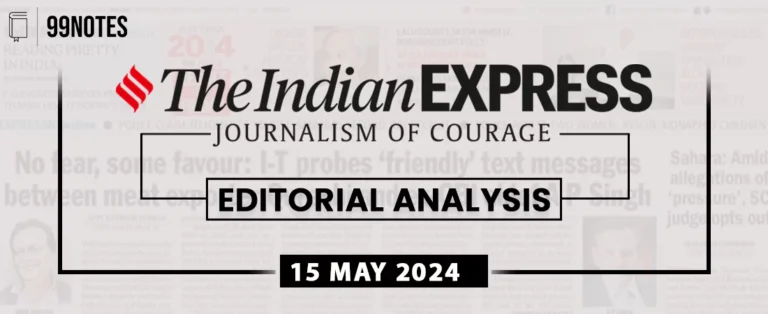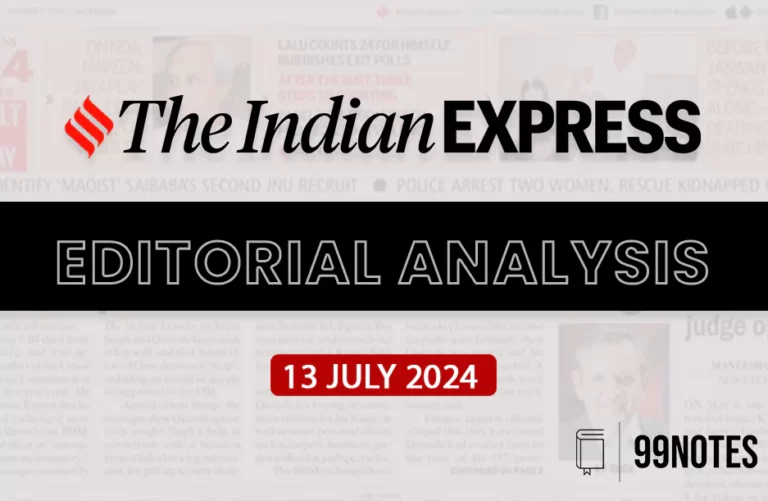29 August 2023 : Indian Express
Indian Express
29-August–2023
The Indian Express, CSE candidates can stay informed about current events and developments in India and around the world.
1. BRICS in perspective
Context:
- The 15th BRICS Summit concluded in Johannesburg with the membership of the grouping going from 5 to 11, after the induction of four countries from the Gulf and West Asia—Egypt, Iran, Saudi Arabia and the United Arab Emirates—as well as Ethiopia and Argentina from Africa and South America, respectively.
Contradictory Statements:
- Both Indian and Chinese side came out with somewhat contradictory readouts.
- The Chinese Ministry of Foreign Affairs claimed that the meeting was organised at India’s request, while we have put out that there was a pending Chinese request.
- There was also divergence on what transpired during the interaction.
- Our briefing indicated that the two leaders agreed to “direct their relevant officials to intensify efforts at expeditious disengagement and de-escalation”, while the Chinese statement suggested that the two sides should “bear in mind the overall interests of their bilateral relations and handle properly the border issue so as to jointly safeguard peace and tranquility in the border region”.
- This discordance is emblematic of the present state of India-China relations and their different positions on border-related issue.
The Johannesburg Declaration:
- The Johannesburg Declaration refers to “consensus” being reached on “the guiding principles, standards, criteria and procedures of the BRICS expansion process”, details of which have not been made public so far.
- The initiative for the expansion of BRICS came from China, with the support of South Africa and Russia.
China’s clout in BRICS:
- While India has good relations with all six new members, the ability of China, the largest economy and most influential country in the grouping, to drive the agenda and future direction of BRICS should not be underestimated.
- It is sobering to recall that China has been the key player in most of the milestones in the evolution of BRICS since its inception in 2006.
- The first expansion in 2010 with the inclusion of South Africa.
- The establishment of the New Development Bank in 2015 with its headquarters at Shanghai, even though the idea of a BRICS bank was proposed by India.
- The setting up of the Contingent Reserve Arrangement in 2015 with China as the largest contributor ($41 billion as against $18billion contributed by India).
- China mooting the “BRICS Plus” arrangement at the Xiamen Summit in 2017.
- Now the enlargement of the grouping with more members to come.
What should India do?
- Looking ahead, India will have to guard against BRICS emerging as an anti-West grouping and as an instrument in China’s power play as China had launched veiled attacks on the US led West.
- China had accused “some countries” of attempting “to expand military alliances to seek absolute security, stoke bloc-based confrontation by coercing other countries into picking sides, and pursue unilateral dominance at the expense of others’ rights and interests”.
- China used a similar language at the Johannesburg Summit.
How BRICS expansion could be problematic?
- Apart from the profound differences between India and China, we now have tensions between Iran and Saudi Arabia which are deep-rooted despite limited rapprochement.
- There are also fault lines between Saudi Arabia and the UAE.
- Besides, many of the members do not pass the test of economic vibrancy, a consideration that shaped the launch of the original BRIC platform of countries, which were expected to emerge as the dominant players in the global economy.
- Lacking internal coherence and with sluggish economies of several member countries, an expanded BRICS may just end up being more unwieldy and contentious, unless steps are taken to prevent it from becoming more political and strategic.
What should be India’s agenda?
- India’s agenda should be to encourage the economic and developmental priorities of the grouping and use it to articulate the concerns and aspirations of the Global South and promote its engagement with the latter.
- We must be wary of projects like the BRICS currency (a not-starter) or de dollarisation.
- Alternative payment mechanisms can be explored but that can be done under bilateral arrangements.
- Given our problems with China and its proclivity for weaponizing economic interdependence, it does not serve our interest to promote a larger role for the Chinese Yuan in global trade or as a reserve currency.
Way Forward for India:
- India will have to devise a careful strategy to ensure that the grouping is not dominated by China to advance its strategic agenda.
- This is feasible because all decisions are taken in BRICS on the basis of consensus and there is a lack of appetite among other member countries, except for Russia and Iran, to take sides in the Sino-US rivalry.
- India will have to engage the grouping proactively and not shy away from wielding its veto in decision-making and exposing China’s hypocrisy on issues like the expansion of the UN Security Council, which figured in the Johannesburg Declaration.
- Finally, India should continue to not let its bilateral differences with China come in the way of its engagement with platforms like BRICS and SCO where China is playing an increasingly central role.
- There is a good case for stepped-up involvement while recognizing the limitations of these groupings and the need for countering Chinese dominance.
2. A force to reckon with
Context:
- India’s Growth trajectory and its growing international relevance has fueled it’s great power ambitions. What was once a dream seems an achievable reality shortly.
- India is increasingly being looked at with respect and with an expectation of a role of greater responsibility in world affairs.
- The recent increase in the participation of the Indian Air Force in international exercises with key strategic players is an acceptance of the role air power plays in national interest and security.
How is India bolstering its Air Power capabilities?
- For a nation that has not always understood and leveraged airpower adequately despite its significant role in five wars and years of consistent and dedicated service, there is a definite change in the air.
- National security is no longer hyphenated to the land and maritime domains and is slowly transitioning towards a future-focused, multi-domain security approach.
- The inclusion of the IAF in the Army’s regular border talks is an important development.
- Given the growing capabilities of the PLA’s air force, an increase in the deployment of Indian air power for political signalling and coercion in airspaces in disputed areas may not be far off.
- Pressing it into service in the Indian Ocean which is the lifeline of India’s trade, commerce and security imperatives and indispensable to the stability of the region is also a strategic necessity.
- All elements of the nation’s military power must be included in India’s security construct to ensure a wider basket of strategic responses and options.
- The approval of the deal to procure 26 maritime versions of the Rafale combat aircraft underscores two aspects—the critical role of airpower in the maritime domain and the enhancement of the much-needed interoperability between land-based airpower of the IAF and carrier-based airpower of the Navy.
- India’s Defence Acquisition Council has approved the Rafale fighter for the Navy. But it will be at least four years before deliveries begin, excluding the time to operationalize the platform in its designated roles.
- This is where the IAF’s strategic capabilities must be leveraged, while also expanding its multi-domain capacity by swiftly rebuilding its combat bench strength.
How other countries used aircrafts for diplomacy?
- The US’s use of aircraft carriers have played a significant political role in its coercive diplomacy as it seems to have had an impact on China.
- The two China seas and its ports are the wellsprings of Beijing’s economic power. Its security outlook is determined by the strategic concerns of the US and other nations frequenting the regional waters and airspace for reconnaissance, show of force and presence by exploiting the principle of “freedom of navigation”.
- China, therefore, seeks aircraft carriers to overcome the limits of its geography, assert its reunification strategy with Taiwan, counter maritime claims in the South and East China Seas and protect its sea lines of communication in the Pacific region.
How has India used air diplomacy?
- New Delhi seems to have appreciated the Air Force’s vital role in India’s national and regional security, as well as foreign policy.
- This is evident from the seven air exercises that India has participated in this year with the air forces of the US, France, Japan, UK, Greece and the UAE, as well as the 12-nation mega air exercise planned in October-November.
- This is not only in sync with India’s bold foreign policy, but also signals international recognition of the IAF’s professional capabilities and the larger role of air power in the Indian Ocean and the Indo-Pacific regions.
- It’s also an affirmation of the salience of land based power.
The Chinese threat:
- China’s growing use of its air force to implement its coercive foreign policy and revisionist strategies is evident in the Taiwan Strait and the East and South China Seas.
- Its recognition of India’s asymmetric air power advantage during the Depsang and Galwan crises has also led Beijing to deploy airpower infrastructure in the Tibet Autonomous Region.
- As China continues to pursue a strategy of expansion to “regain its perceived historical territories and maritime spaces”, India’s border issues with it are likely to get more complex.
- The direct access provided by the China Pakistan Economic Corridor to the Arabian Sea through the Gwadar port and the China-Myanmar Economic Corridor which opens into the Bay of Bengal at Yangon and Kyaukpyu are vital to Beijing. They help it tackle its Malacca dilemma.
- From India’s perspective, both routes not only give China access to the Indian Ocean but also allow it to strategically sandwich India’s eastern and western coasts.
- The Gulf of Aden, Malacca and Sunda Straits are similarly of equal strategic importance to both countries.
Way Forward:
- Only India has the unique strategic advantage of dominating the airspaces over these vital maritime spaces with its land based airpower capabilities.
- This capability will significantly bolster India’s national security, its regional presence and geo-political standing.
- Engaging, training and exercising with the friendly regional air forces opens up several possibilities.
- Leveraging airpower offers several benefits — creating a unique hard power deterrence over the South China Sea, ensuring maritime and aerial freedom in the Indian Ocean region for all and enabling aerial access to strategically located air bases amongst friendly countries in the region.
- It also gives India the option of exercising its soft power by providing humanitarian assistance and disaster relief.
For Enquiry

29 August 2023 : Indian Express

29 August 2023 : PIB

29 August 2023 : The Hindu Editorial Notes PDF

29 August 2023 : Daily Current Affairs

Daily Prelims Quiz :Chalcolithic and Harappan Age

28 August 2023 : Daily Answer Writing

28 August 2023 : Daily Quiz

28 August 2023 : Indian Express

28 August 2023 : PIB

28 August 2023 : The Hindu Editorial Notes PDF
August 2023 Indian Express 29 August 2023 : Indian Express Indian Express
29-August–2023
The Indian Express, CSE candidates can stay informed about current…
August PIB 2023 29 August 2023 : PIB PRESS INFORMATION BUREAU
29-August -2023
Daily Current Affairs For UPSC ,The PIB ( Press Information…
August- The Hindu Editorial 29 August 2023 : The Hindu Editorial Notes PDF The Hindu Editorial
29-August-2023
Daily Current Affairs For UPSC ,The Hindu Editorial Summary
Facebook-f
Twitter
Youtube
1….
August Daily Current Affairs 29 August 2023 : Daily Current Affairs Daily Current Affairs
29-August-2023
Daily Current Affairs For UPSC ,Daily Current affairs of The hIndu…
Hiistory Prelims Quiz Daily Prelims Quiz :Chalcolithic and Harappan Age Daily Prelims Quiz
Week 1 Day 1
Instructions
1. All 5 Questions are Compulsory.
2. Each question carries…
mains answer writing 28 August 2023 : Daily Answer Writing Mains Answer Writing
One of the key components of these exams is the written test, which consists of…
Daily Quiz 28 August 2023 : Daily Quiz 28 August 2023: Daily Quiz…
August 2023 Indian Express 28 August 2023 : Indian Express Indian Express
28-August–2023
The Indian Express, CSE candidates can stay informed about current…
August PIB 2023 28 August 2023 : PIB PRESS INFORMATION BUREAU
28-August -2023
Daily Current Affairs For UPSC ,The PIB ( Press Information…
August- The Hindu Editorial 28 August 2023 : The Hindu Editorial Notes PDF The Hindu Editorial
28-August-2023
Daily Current Affairs For UPSC ,The Hindu Editorial Summary
Facebook-f
Twitter
Youtube
1. Himalayan…



